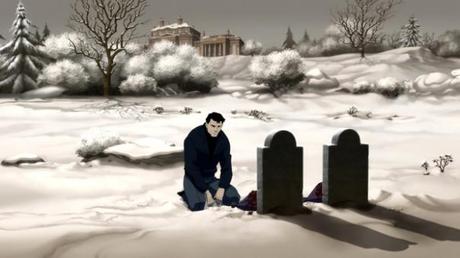
Even before the release of the original Batman: Year One almost twenty-five years ago, there were probably few origins in popular culture better known than the one for its eponymous character: a young boy and his parents go down the wrong alley one dark night, and after a chance encounter with a trigger happy mugger, the parents lay dead and the young boy is scarred forever. Decades later, that boy, after spending his life training to be the world’s greatest crime-fighter, grows to become the Batman: protector of Gotham City and arguably the greatest superhero of all time (and certainly the most culturally versatile). If the origin was well known 25 years ago, it’s positively burned into the popular imagination now, with the beginnings of Batman having been reiterated in different ways, through two major blockbuster films, three (or arguably four or five) animated series, a major video game release, and numerous other comic book reinterpretations. Yet through all of it, Batman: Year One, written by the legendary Frank Miller and illustrated by David Mazzucchelli, though not the first and hardly the last of Batman’s origin stories, still stands as perhaps the best and most resonant. Therefore it’s not surprising that DC Animated films and Warner Premiere would produce an animated adaptation of Batman: Year One; besides being entirely in keeping with their stated intention of reproducing and reinterpreting classic works of the DC Comics canon, the project would seem to be an almost commercial and creative slam dunk. Unfortunately, DC Animated’s Batman: Year One proves to be a fitting illustration of the difficulties that can sometimes transpire in transposing one medium to another; even two mediums that seem as inherently similar as comic books and animated film.
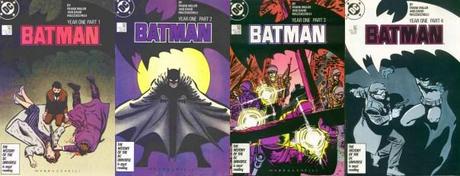
"Batman" issues 404 - 407: The four parts of Frank Miller and David Mazzucchelli's landmark "Batman: Year One."
It’s difficult to emphasize for those uninitiated to comic book history and culture how important a work Batman: Year One really is. Originally printed, almost inauspiciously, in Batman comics over four issues back in 1987, Year One reimagined the origin of the famous Dark Knight for what was, both then and now, a more contemporary context. Year One was Miller’s follow up to The Dark Knight Returns (which conversely was about a much older Batman at the end of his career); it related the first calendar year of the Batman’s crime-fighting career through the contrasting perspectives of both his alter-ego Bruce Wayne and his future ally Lieutenant James Gordon. Returning to Gotham City for the first time in years, Wayne sets out to fulfill his oath to avenge his parents’ murders through combating crime in all its forms. His first foray into vigilantism goes badly, though; the hard-edged street criminals of Gotham City treat the mortal man as joke, and he’s nearly shot to death by members of Gotham’s amoral police force. Realizing that he needs to instill fear in criminals, a wounded Wayne prays to the spirit of his dead father for guidance; almost in response, a lone bat flies in through his window, giving him the inspiration to use its likeness to way of making his enemies afraid. Meanwhile, Lt. Gordon, long before he was to become Gotham’s Police Commissioner, transfers in from Chicago and immediately runs up against the prevalent corruption within the Gotham City Police Department. After proving a nuisance to the unrepentantly dirty Commissioner Loeb and his flunkies, Gordon is given the thankless task of hunting down Gotham’s new vigilante. It’s not long, however, before Gordon begins to realize that this mysterious new “Batman” may potentially be his most valuable ally…
Incorporating a more realistic, mature, and darker tone than what was typical even for Batman comics at the time, Year One reinvented and reinvigorated many aspects of the character’s mythology by making it more in sync with the modern tropes of urban society. While plot elements such as police corruption, vice, drugs, organized crime, and urban decay were not foreign to Batman comics prior to Year One, they became vital and ingrained in them from that point on. The aspect of societal corruption that Miller introduced gave Batman a deeper, more renewed significance going into the later part of the 20th century. His raison d’être ultimately became much more philosophical; instead of the typical costumed superhero, the Dark Knight’s onus afterward was to be the response to an unfulfilled social contract, who becomes necessary when the police in a corrupted society have violated their pact with the populace by failing to uphold law and order. Though the noble-hearted Jim Gordon fights against the deeply ingrained police corruption by using those very rules of law and order, in the end he can only do so much; the mysterious new vigilante and his guerilla war become a necessity when the rule of law fails against the cops and gangsters. As both Batman and Gordon eventually understand, one needs the other to ensure that justice for Gotham can hope to be properly served.
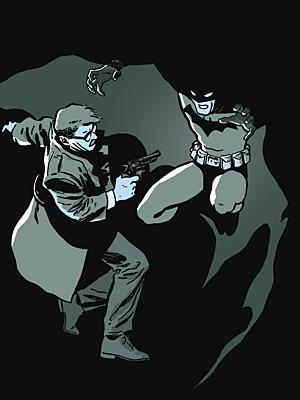
The brilliance of "Year One" was the thematic dichotomy between Lt. James Gordon and the Batman; each of whom represented different sides of the law and order spectrum.
As lauded as it is, there are things that have been criticized about Batman: Year One. For some comic book traditionalists, the story is more a hardboiled noir than a traditional superhero yarn, and thus somewhat more low-key in scope and pacing than what was, and is, common in traditional superhero media. Its narrative isn’t a clean, organic, self-contained plot as much as it is a “slice of life;” Year One isn’t about the foiling of a criminal conspiracy or the defeat of an enemy in an epic final battle as much as it is about the gradual forging of a friendship in the face of common desires. Also atypical for popular Batman media, the comic doesn’t feature a major super-villain save for a brief, unresolved subplot involving Selina Kyle’s transformation into Catwoman (which serves as a side commentary on how the presence of a Batman inevitably leads to an escalation in the tactics of criminals). In truth, very little of Year One’s narrative threads are actually resolved; its main purpose is to ultimately serve as an adequate prologue to every Batman story written before and since. People like me consider these things to actually be strengths of the work rather than its weaknesses; freed of the burdensome tropes of the “superhero” story, Year One becomes more about its themes and its character dynamic, thus making it more extraordinary than ordinary. What I do think should provoke criticism about the work, though, was the fact that it represented, albeit mildly, Miller’s tendency to present villains that are coded racially, ethnically, or socially: Catwoman in Year One is a lesbian dominatrix with an underage prostitute lover, Loeb the villainous Police Commissioner is Jewish, the chief gangster Carmine “the Roman” Falcone is Italian, the drug lord Skeevers is African-American, and even the corrupt Detective Flass appears almost Teutonic. While the coding isn’t always stereotypical and honestly can easily go unnoticed while reading the graphic novel for the first time, Miller’s recent migration toward extreme right-wing Islamophobia have made the characterizations, in retrospect, somewhat questionable and maybe even a little troubling.
While Miller’s writing of Year One may have been some of his best work, the artwork of David Mazzucchelli was as good if not superior to the material. Culminating the darker turn Batman had taken since the early 1970s, Mazzucchelli’s illustrations were gritty, hardboiled, and realistic while simultaneously evocative works of dark, urban impressionism. His characterizations, too, were incredibly detailed and distinctive, and he displayed an amazing knack for conveying the intensity of actions, violence, and mood so that they felt almost visceral. The landscapes and buildings in his Gotham City, colored in muted tones by Richmond Lewis, seemed to almost be dissolving from moral, economic, and criminal decay. It’s some of the best drawings ever in a graphic novel; a hard standard for any work of animation to match.
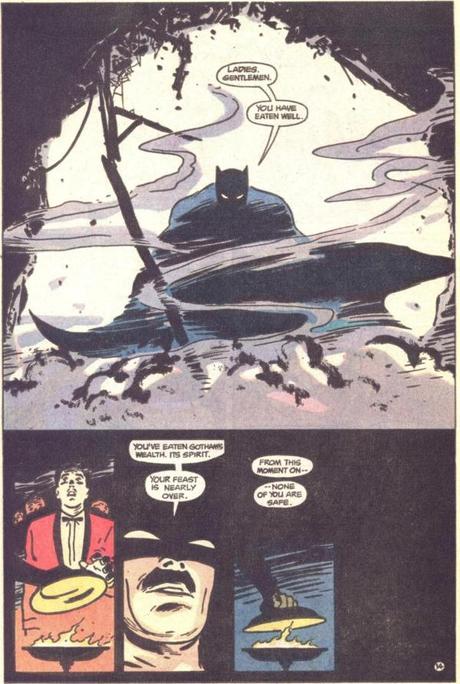
The evocative art of David Mazzucchelli from the origianl "Batman: Year One."
In that respect, and others, I sympathize with the makers of the animated Batman: Year One, in that, no matter what they might have produced, it would most certainly have suffered from the burden of expectations. Their end result, while hardly terrible, remains fairly underwhelming and surprisingly kind of bland. Which is somewhat surprising, at first glance, because on a surface level the film appears incredibly faithful to its source; it is, in fact, very nearly a scene-for-scene recreation. The script, by Tab Murphy, does alter some spoken dialog and makes some minor changes for content: the makers eliminated Jim Gordon’s smoking habit (though, strangely, not the character’s extra-marital affair), as well as Catwoman’s man-hating dialogue, and scenes that involved drug use have been altered to exclude it. Some of the few fight scenes, portrayed as quick and brutal in the comic, are also here often dragged out and embellished in order to increase the action content. Those changes are pretty much cosmetic and neither adds nor subtracts from the work much. The problem is actually larger and much more deeply ingrained, and can be linked to two very big words: simulation and simulacra.
The late philosopher Jean Baudrillard, in his seminal work on postmodernism, Simulation and Simulacra, described how the semiotic concepts of the sign can be reproduced and represented by the act of recreation through simulation and simulacra. A simulacrum (singular), in simplest terms, is a superficial likeness or recreation of something. As expounded on by Baudrillard, one of the more notable simulacra is a recreation or reappropriation of signs that no longer holds the same context or signifies precisely the same content as what it has recreated. In regards to the animated Year One, it becomes a very real simulacrum, because, despite its own apparent adherence to the original work, it actually recreates it without often completely understanding the proper contexts of why things worked in the original.
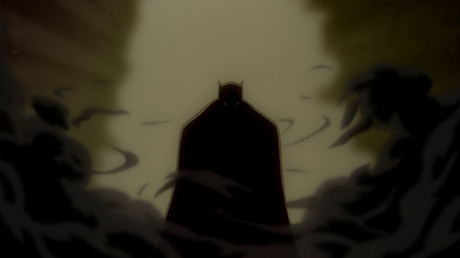
The animated film's simulation of one of Mazzucchelli's iconic images (as seen above).
The very serious disconnection in the work seemingly occurs because either the directors, Lauren Montgomery and Sam Liu, and/or the producers, such as Bruce Timm and others, tried to ostensibly recreate the comic verbatim without compensating for the role the first person narration prevalent in the original comic played in placing the characters and narrative action in their proper context. For instance, there’s a scene in the comic where Batman, in one of his first forays in his costume, attacks three teens in the middle of robbing an apartment. The actual action in the scene is brief and not very complicated: the inexperienced Batman nearly knocks one of the teens off a fire escape, and while saving him is attacked by his two panicked accomplices. Batman defeats them, rescues the boy, and then lies there, mentally berating himself for being a “lucky amateur.” In the comic, the scene is overlaid with Wayne’s first person narration describing his feelings, his observations, his ethics, the context of his actions, and his physical pain, giving the scene most of its actual content. Conversely, when portrayed by the film, it lacks all of that narration save for the final berating, and therefore just kind of becomes a brief, inauspicious scene, that makes a point, but does so with limited emotional and narrative context.
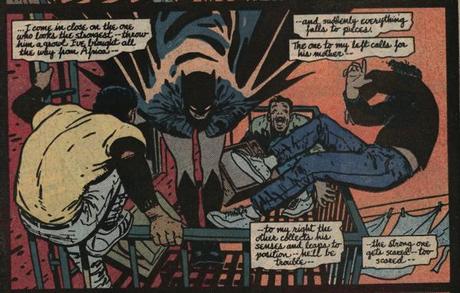
The fire escape scene from the original comic of "Batman: Year One," which was predominantly driven by the first person narration of Batman/Bruce Wayne; all of which is absent in the animated film version.
The film, unfortunately, is filled with instances like that. For the most part, the filmmakers attempt to retain some of the first person narration of the book, and sometimes effectively. But too many of those instances occur in scenes where there is no narrative action, and for the most part we’re only seeing visuals when visuals are only half the story. Unfortunately, given how much context is actually removed from the visuals, the entire film feels sort of dull and lethargic at times. The character of Bruce Wayne, in particular, gets especially underserved by the film; without compensating for his narration or internalized voice in any real way, the character’s motivations, goals, and changes are unfulfilled by the narrative. In essence, the Batman in the film fails to exist on its own terms, and really becomes little more than a palimpsest of the character from other works. For instance, the very crucial moment in the comic where Bruce Wayne rationalizes his mission and realizes that he needs Jim Gordon as an ally, is completely absent in the film. Without that, a large part of the core dynamic that makes up the relationship between he and Gordon from the comic (and that made it so resonant) becomes kind of fuzzy here, as we get the story almost entirely from Gordon’s side and none of it from Batman’s. As a result, almost all of the deeper themes, ideas, and narrative depth I described above are all pretty much lost.
Of course, being a visual work adapted from another visual work, the animated Year One also becomes an empty simulacrum in both its actual animation and its voice work. I’ll start with the voice work, which basically emphasizes good performers doing good work in roles for which they have been miscast. “Geek Goddess” Eliza Dushku, who plays Catwoman, would in some other Batman piece make for a smart, sassy, sexy Catwoman, but that’s not Miller’s Catwoman, who, to be blunt, is very tough, very reactionary, and very, very butch (the Catwoman she portrays in the eponymously titled short that accompanies the Blu Ray/DVD is much more appropriate to her vocal style). Veteran actors Jon Polito and Alex Rocco are both more than competent performers, but they’re just all wrong here. Some of Polito’s line readings for Loeb are almost painfully awkward, as the role calls for a genial old man with a sinister underside rather than Polito’s typically gruff tough guy. Rocco, unfortunately, is so well known for his role on The Simpsons (as Roger Meyers, Jr.) that it seems ludicrous for him to voice the debonair and threatening Roman, but even disregarding that, his voice proves too broad and gravelly for the character. In all three cases, the filmmakers just seemed to have no grasp for the characters they were casting. As Batman and Bruce Wayne, Benjamin McKenzie’s voice work is passable, but he sounds a little too much like a monotone Hal 9000 during some of the narration sequences. The excellent Bryan Cranston stands as the sole exception to the miscasting; he does a fine job with Gordon, and would be an ideal choice to play the character in a live action setting.
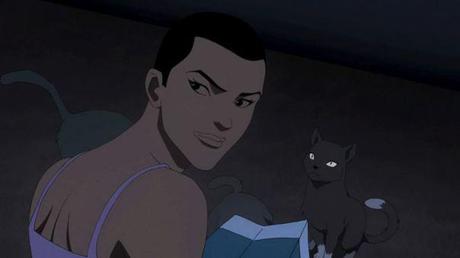
Miller and Mazzucchelli's version of Selina Kyle/Catwoman was not quite conducive to the vocal talents of Eliza Dushku, nor vice versa.
As for the animation, on its own, the work is often superb and actually the film’s best aspect, utilizing Mazzucchelli’s original character designs rather well. The problem in comparison to the original work, and again this falls under the umbrella of the simulacrum, is that it’s very hyperrealized; a large part of Mazzucchelli’s impressionistic touches are lost and the Gotham City of the film completely lacks that aura of decay that was so core to the comic. Instead, the background and the city are far, far too clean and glossy, again sacrificing a large element of the comic’s original subtext. Some scenes even feature pristine blue skies, which are entirely contrarian to the environment and aura that the film, as an ostensible recreation of the graphic novel, should have done a better job representing. Instead, it seemed like either the directors or the animators attempted to polish what they saw as Mazzucchelli’s imperfections, again allowing the entire enterprise to become disconnected from the meaning of its original presentation, just like a simulacrum.
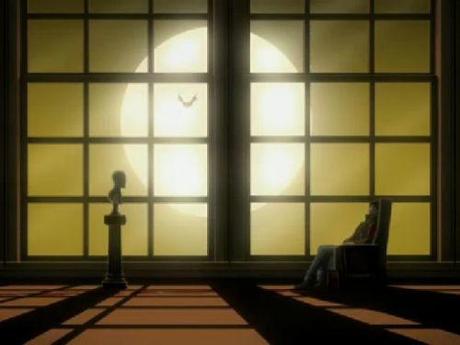
Though overly hyper-realized for the story it interpreted, the animation in "Batman: Year One" is generally superb.
Again, it would be grossly unfair to call the animated version of Batman: Year One a bad movie. It’s clear, compelling enough, well animated, and though never particularly exciting, at a little over and hour in length it never really drags. On one level, as well, it stands as more mature and sophisticated than nearly any other animated Batman presentation out there. Yet even from a fully qualitative standpoint, Batman: Year One just doesn’t really work, and it’s entirely because without adequately representing the deeper themes and compelling dichotomy of Batman and Gordon at its heart, then what one is left with a fairly average animated film that’s light on action and narrative depth. To be fair to DC Animation, again, whatever they would have made would have suffered from the burden of expectations, and I don’t doubt that their intentions in transposing the comic may have seemed perfectly sound. Yet they would certainly been better off attempting something of a more free adaptation of the work, one that would have conveyed the context and characterizations inherent to Miller and Mazzucchelli’s work without marrying itself to the finite details that really weren’t the point to begin with (they certainly could not have gone farther afield than what Miller and Darren Arnofsky intended to do with their once proposed film version of Year One.) From an intellectual perspective, at least for me, the animated version proves interesting as a misfire for being an almost perfect example of a simulacrum. However, I fail to see how anyone could watch Batman: Year One and walk away with any conception of why the original comic remains such a definitive classic. And that can’t be regarded as anything other than a failure.

